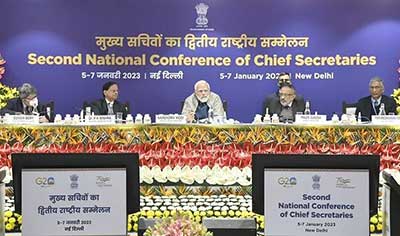Date: 25/01/2023
Relevance: GS-2: Welfare schemes for vulnerable sections of the population by the Centre and States and the performance of these schemes; mechanisms, laws, institutions and Bodies constituted for the protection and betterment of these vulnerable sections.
Key Phrases: Aspirational Blocks Programme, Governance, Underdeveloped Blocks, Aspirational Districts, Health, Nutrition, Financial Inclusion, Skill Development.
Context:
- During the Second National Conference of Chief Secretaries, the Prime Minister launched the Aspirational Blocks Programme (ABP).
- This transformational programme focuses on improving governance to enhance the quality of life of citizens in the most difficult and underdeveloped blocks of India by converging existing schemes, defining outcomes, and monitoring them on a constant basis.
About Aspirational Blocks Programme:
- An inter-ministerial committee in consultation with states had identified 500 blocks from across 28 states and four Union territories.
- In each of them, the ABP will focus on monitoring 15 key
socio-economic indicators (KSIs) categorised under major sectors
namely:-
- Health and nutrition
- Education
- Agriculture and water resources,
- Financial inclusion and skill development
- Basic infrastructure
- Social development.
- These themes were selected for facilitating holistic development of every block with states having the flexibility to include additional state-specific KSIs to address local challenges.
- The KSIs will be tracked on a real-time basis and periodic rankings will be released across key thematic areas to foster a healthy and dynamic competition among the blocks to encourage data-driven governance.
Importance of Blocks or Development Blocks:
- The focus on blocks echoes the historic importance of blocks or development blocks introduced in 1952 to provide for a substantial increase in the country’s agricultural programme, and for improvements in systems of communication, in rural health and hygiene, and in rural education.
- Development blocks ensure that a larger than proportionate share of development reaches the marginalised and vulnerable sections of the population by building social and economic infrastructure.
- As an administrative and monitoring unit, the block ensures that a
“one-size-fits-all” approach is not applied to every part of the
country.
- Instead, the block administration can adopt customised approaches towards improving socioeconomic indicators based on the context of the region and the most emergent needs.
Aims and Objectives of ABP:
- The ABP aims to address the inequalities by improving governance
and last mile service delivery at the block level.
- As key drivers of this initiative, states are expected to guide, support, review and build capacity of relevant officers to drive progress under this programme.
- Under the leadership of the district administration, the officers at the
block level will improve critical last mile service delivery.
- They will focus on improving the infrastructure at the block level to aid social welfare development.
- Several departments of the block administration will converge and work in union to bridge critical administrative gaps and sustain these developments and improvements for a long period of time.
- It also provides a common platform for all block administrations to showcase their best practices and learnings.
- The ABP is built on the success of the government’s flagship Aspirational Districts Programme (ADP) launched in 2018 across 112 under-developed districts of India.
Success of Aspirational Districts Programme (ADP)
- The ADP has shown that if development is taken as a “Jan Andolan” and progress of a district is constantly monitored, success would follow.
- In the last five years, many aspirational districts have bettered their
performance, across several indicators, then the state average values.
- For example, Paschimi Singbhum, a district in Jharkhand and a left-wing extremism-affected area, has raised registration of pregnant women within the first trimester from just 39 per cent in 2018 to 91 per cent in 2022.
- Districts such as Gumla in Jharkhand, Karauli in Rajasthan, Namsai in Arunachal Pradesh, and Dhalai in Tripura have increased the percentage of institutional deliveries from around 40 per cent to more than 90 per cent.
- Kupwara in Jammu and Kashmir has increased the percentage of secondary schools with functional electricity from less than 50 percent in 2018 to more than 95 per cent in 2022.
- Districts like Dhenkanal in Odisha, where less than 50 per cent children were immunised up until 2018, have now gone beyond the 90 per cent immunisation rate.
- The Finance Minister in her Union Budget speech of 2022 mentioned that 95 per cent of 112 aspirational districts have made significant progress in major indicators such as health, nutrition, financial inclusion, and skill development.
- However, she also highlighted that some blocks continue to under-perform. The reasons for this can be multi-layered i.e. difficult terrain, lack of resources, historical injustice, social marginalisation and community vulnerability, among others.
Conclusion:
- ABP will aid the achievement of critical targets identified under the Sustainable Development Goals (SDGs) and enable the blocks to contribute to India’s GDP.
- The programme strives to protect the rights and uphold the dignity of every single citizen by increasing their awareness and enhancing access to government schemes.
- A “viksit” block is the foundation for a “viksit” Bharat. This forward-looking programme will leverage the three Cs of convergence, collaboration, and competition to achieve this vision.
Source: The Indian Express
Mains Question:
Q. A “Viksit” block is the foundation for a “Viksit” Bharat. The Aspirational Block Program can leverage the three Cs of convergence, collaboration, and competition to achieve this vision. Discuss (150 words).







